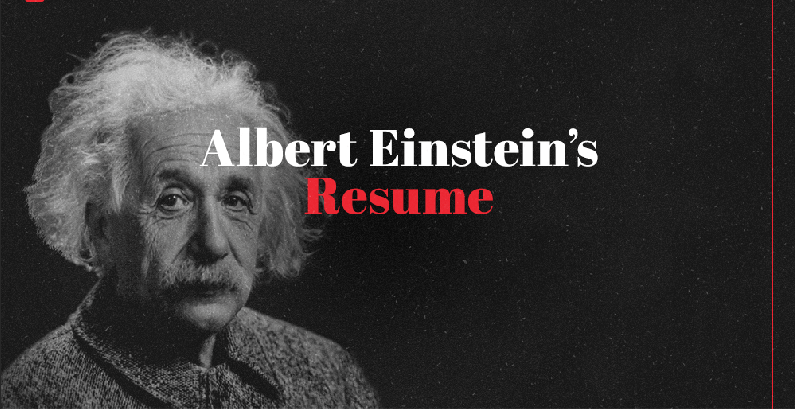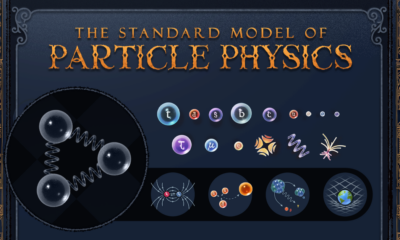Misc
Timeline: The Incredible Life of Albert Einstein
Albert Einstein was one of the most brilliant and influential mathematical physicists in human history. Even 62 years after his passing, he is still widely regarded as the prototypical genius.
Today’s timeline from KickResume is an inventive and entertaining look at Einstein’s life and achievements.

Younger Life
Albert Einstein was born on March 14, 1879, in the German city of Ulm. From an early age, Einstein was fascinated by mathematics, science, and music.
While he would eventually go on to reveal the inner workings of the universe, Einstein struggled as a student, failed exams, and had dust-ups with authority figures.
In 1903, he married a former classmate, Mileva Marić, though his parents disapproved. Recently discovered letters indicate that Marić – who was also a physicist – may have contributed significantly to his groundbreaking work. The couple had a daughter in 1902 (who was given up for adoption), and later had two sons.
Annus Mirabilis
In 1905, Albert Einstein was working as a clerk in the patent office in Bern, Switzerland. The 26-year-old had only recently submitted his doctoral thesis to the University of Zurich, but was hard at work writing four papers in a single year that would eventually turn the world of science on its head. That is why 1905 is often referred to as an annus mirabilis (or “miraculous year” in Latin).
To summarize: Albert Einstein laid the foundation of quantum physics, introduced special relativity, and established the scientific basis of nuclear energy in his spare time.
From Science Star to Supernova
By 1919, while working as a professor of theoretical physics at the University of Berlin, Einstein theorized that an impending solar eclipse would provide a rare opportunity to observe gravity’s effect on light. When reports came back that his predictions were proven correct, it not only sent a shock-wave through the scientific community, but the whole world.
New Theory of the Universe. Newtonian Ideas Overthrown.
– Headline in the London Times
Years after Einstein’s miracle year, his immense accomplishments started to become common knowledge. The physicist, now an overnight celebrity, spent the next few years traveling, doing speaking engagements, and collecting awards. He was also a founder of the Hebrew University in Jerusalem in 1921, and won a Nobel Prize that same year.
Albert Einstein was an outspoken pacifist and Jew, so as Hitler rose to power in Germany, he made the decision to emigrate to the United States. He accepting a position at the Institute for Advanced Study in Princeton, New Jersey. The physicist would never set foot in the country of his birth again.
Einstein and the Atomic Era
A month before World War II, Einstein and his colleague, Leo Szilárd, wrote numerous letters to President Franklin D. Roosevelt sounding the alarm that Germany was developing “extremely powerful bombs of a new type”. The President took the letters seriously and soon after, the Advisory Committee on Uranium (a precursor to the Manhattan Project) was created.
Einstein carried the guilt of his role in sparking the development of atomic weapons, and he would continue to speak out against their use throughout the 1940s and onward.
The Fight For Equality
Seeing the parallels between the treatment of Jews in Germany and African Americans in his adopted country, Einstein became a member of the National Association for the Advancement of Colored People (NAACP). He campaigned for civil rights and in a famous speech at Lincoln University, he labeled racism “a disease of white people,” and added, “I do not intend to be quiet about it.”
Later Life
In 1952, Einstein declined an offer from Israel’s premier, David Ben-Gurion, to become president of Israel.
At the age of 76, Einstein suffered an abdominal aortic aneurysm, but opted against surgery upon arriving at the hospital. “I want to go when I want,” he stated at the time. “It is tasteless to prolong life artificially. I have done my share, it is time to go. I will do it elegantly.” Albert Einstein died in his sleep on April 18, 1955.
Though the man himself is gone, the legacy and unique world-view of the eccentric physicist continues to influence and inspire humanity to this day.
VC+
VC+: Get Our Key Takeaways From the IMF’s World Economic Outlook
A sneak preview of the exclusive VC+ Special Dispatch—your shortcut to understanding IMF’s World Economic Outlook report.

Have you read IMF’s latest World Economic Outlook yet? At a daunting 202 pages, we don’t blame you if it’s still on your to-do list.
But don’t worry, you don’t need to read the whole April release, because we’ve already done the hard work for you.
To save you time and effort, the Visual Capitalist team has compiled a visual analysis of everything you need to know from the report—and our VC+ Special Dispatch is available exclusively to VC+ members. All you need to do is log into the VC+ Archive.
If you’re not already subscribed to VC+, make sure you sign up now to access the full analysis of the IMF report, and more (we release similar deep dives every week).
For now, here’s what VC+ members get to see.
Your Shortcut to Understanding IMF’s World Economic Outlook
With long and short-term growth prospects declining for many countries around the world, this Special Dispatch offers a visual analysis of the key figures and takeaways from the IMF’s report including:
- The global decline in economic growth forecasts
- Real GDP growth and inflation forecasts for major nations in 2024
- When interest rate cuts will happen and interest rate forecasts
- How debt-to-GDP ratios have changed since 2000
- And much more!
Get the Full Breakdown in the Next VC+ Special Dispatch
VC+ members can access the full Special Dispatch by logging into the VC+ Archive, where you can also check out previous releases.
Make sure you join VC+ now to see exclusive charts and the full analysis of key takeaways from IMF’s World Economic Outlook.
Don’t miss out. Become a VC+ member today.
What You Get When You Become a VC+ Member
VC+ is Visual Capitalist’s premium subscription. As a member, you’ll get the following:
- Special Dispatches: Deep dive visual briefings on crucial reports and global trends
- Markets This Month: A snappy summary of the state of the markets and what to look out for
- The Trendline: Weekly curation of the best visualizations from across the globe
- Global Forecast Series: Our flagship annual report that covers everything you need to know related to the economy, markets, geopolitics, and the latest tech trends
- VC+ Archive: Hundreds of previously released VC+ briefings and reports that you’ve been missing out on, all in one dedicated hub
You can get all of the above, and more, by joining VC+ today.
-

 Mining1 week ago
Mining1 week agoGold vs. S&P 500: Which Has Grown More Over Five Years?
-

 Markets2 weeks ago
Markets2 weeks agoRanked: The Most Valuable Housing Markets in America
-

 Money2 weeks ago
Money2 weeks agoWhich States Have the Highest Minimum Wage in America?
-

 AI2 weeks ago
AI2 weeks agoRanked: Semiconductor Companies by Industry Revenue Share
-

 Markets2 weeks ago
Markets2 weeks agoRanked: The World’s Top Flight Routes, by Revenue
-

 Countries2 weeks ago
Countries2 weeks agoPopulation Projections: The World’s 6 Largest Countries in 2075
-

 Markets2 weeks ago
Markets2 weeks agoThe Top 10 States by Real GDP Growth in 2023
-

 Demographics2 weeks ago
Demographics2 weeks agoThe Smallest Gender Wage Gaps in OECD Countries














